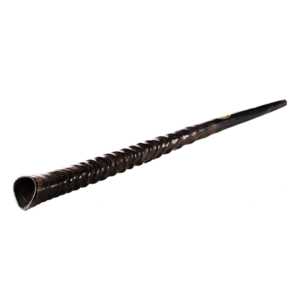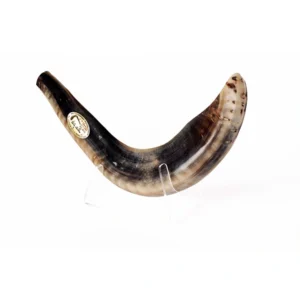FAQ
FAQ
How to blow the Shofar?
Before you take up the Shofar, bring it your lips and take a deep breath, stop for a moment to understand something important: In order to blow the Shofar successfully, you just need to know the right technique. Contrary to popular belief – it does not require a great physical strength. Proper Shofar blowing should be done effortlessly and calmly.
Blowing the Shofar depends on three things:
Blowing:
The air must be breathed out of the abdomen (not the chest) into the mouthpiece of the Shofar, directly and continuously. Most people tend to blow too hard, wanting to make a loud sound, while the result is often a high-pitch, dissonant sound, indicating the blower breathed out more air than the Shofar can hold. We recommend that you try to get “the feeling of the Shofar”, and breathe out the amount of air that will produce the best sound.
The lips
Since the Shofar is an ancient instrument, and is not sophisticated in terms of sound control, it is crucial that the Shofar blower is skilled and able to control his lips’ muscles. Close your lips tightly (but not too tightly) and release the air through one concentrated spot, as small as possible, while vibrating your lips. Practice this, and you will master the blowing technique. Each individual has a specific spot which allows him maximum control of the lips. It is important to find that spot and strengthen it.
inding the right Shofar and mouthpiece:
Sometimes, even if you do everything properly – you won’t be able to make a sound. This usually happens because the Shofar, and especially the mouthpiece, is not suitable for you. Therefore, it is important to choose a Shofar that matches the shape and thickness of your lips, your blowing strength and the desired sound. or that, you should consult an expert. In a regular store selling Shofars, there is a usually certain amount (usually very limited) of Shofars, which means the customers have to compromise. In our workshop, you will enjoy a huge selection of hundreds and thousands of Shofars of every kind. And, if necessary, we can adjust the Shofar especially for you.
Now, all you have to do, is grab the Shofar and start blowing. Good luck!
The sound of the shofar
Teki’ah
The Tekiah is a long sound, but due to the mouth’s position and breath length, most Ba’alei Teki’ah (Shofar blowers) end the long sound with an additional one, sliding to a higher tone. This is a Teki’ah ending with a Glissando, either as a deliberate ornamentation or due to technical difficulties. There is also a Teki’ah with a Glissando at its beginning.
Shevarim
Already in the Talmud (Babylonian 34:2) the Shevarim are described as groaning and moaning sounds. The Shevarim sound like a howl: they are composed of three short and sharp blows sounding like a moan.
Teru’ah
The Teru’ah is (according to Rabbi Yitzhak Arama) the sign of distress and sorrow. It is composed of shorter and more numerous beats than the Shavarim. The Ashkenazi Jews produce Staccato-like, rhythmic beats, while the Mizrachi Jews produce a kind of wavy tremolo, composed on a long sound (like a chain). Normally, in order to produce the long sound’s vibrations, the Shofar Blower uses his tongue.
Teki’ah Gedolah
At the end of the blowing sequence: Teki’ah, Shevarim and Teru’ah (or TaShaT in short), it is customary to blow the Teki’ah Gedola (Grand Blowing): a very long sound, depending on the Blower’s blowing capability. As a rule, the Teki’ah Gedolah is three times as long as the Teki’ah.
How to take care of the Shofar?
Do you need to pour Arak or vinegar into your Shofar to maintain it properly? How do you improve the sound quality of an old Shofar, and how do you clean and sterilize it? Let’s bust some myths and give you some helpful tips, in “Prepare your Shofar for blowing – Dos and Don’ts!”
Where to store the Shofar?
The Shofar should be kept in a ventilated and dark place. We recommend storing the Shofar in a breathable canvas bag, not in a sealed plastic bag.
How to take care of the Shofar?
The best way to take care of the Shofar is simply… to do nothing! If the Shofar suits the person using it – there is no need to do anything, more likely than not, you would just damage it. Some people pour Arak, vinegar or wine into the Shofar, thinking the liquid will improve its sound. This is a mistake! The horn absorbs and soaks up the liquids, which dim the sound temporarily. Ba’alei Teki’ah who wash the Shofar before Rosh HaShanah are unpleasantly surprised to find out the Shofar sound has changed. This is because the horn is not sufficiently dry.
What should you do?
The only thing we recommend you do, when using the Shofar on Rosh HaShanah, is clean the mouthpiece and drill hole with a cleaning rod. Cleaning rods can be purchased at our workshop, or if you wish to make one yourselves – use a pipe cleaner or some feathers sterilized with alcohol. The cleaning rod should soak up the saliva left inside the Shofar during blowing, and keep it clean and dry.
How much Shofar cost?
The cheapest shofar costs NIS 80, and the price increases with the quality and size, but you can find a shofar that will suit any person in any budget.




